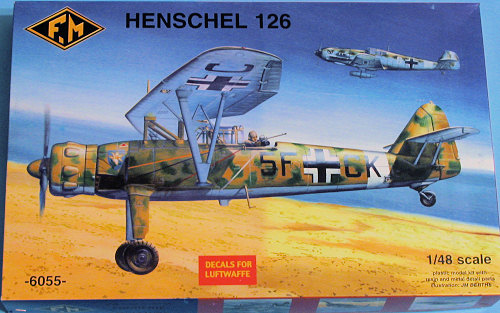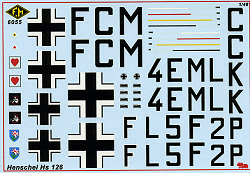
| KIT: | Fonderie Miniature 1/48 Hs-126 |
| KIT #: | 6055 |
| PRICE: | $67.95 at GreatModels |
| DECALS: | Three options |
| REVIEWER: | Scott Van Aken |
| NOTES: | Short run multimedia kit |

| HISTORY |
The Hs-126v1 first flew in 1936 as a reconnaissance and army cooperation aircraft, powered by a liquid cooled Jumo 210, pending the availability of the new Bramo-Fafnir 323 air cooled engine.
Two more prototypes followed and after evaluation by the Luftwaffe, which showed not only good handling qualities, but good short landing and take-off (STOL) characteristics. Ten preproduction Hs-126A-0 aircraft were ordered in 1937 and delivered for operational trials.
Early spring of 1938 saw the first production Hs-126A-1 aircraft sent out to Luftwaffe squadrons, now fitted with the BMW 132D with 880 hp available for take off. Armament was a single 7.9 mm gun in the forward cowling and a flexible gun of the same calibre for the radio operator/gunner. During the fall of 1938, 30 were dispatched to Spain to operate in the Condor Legion where they replaced the elderly He-45. They were much appreciated by the crews and proved to give excellent service. In 1939 the Hs-126B was developed in time for the Poland campaign where it was also used as a light bomber. It was also effectively used in the Battle for France.
By 1942, the type was showing its age and was slowly replaced by the FW-189. It was then relegated to second line units for things like glider towing and anti-partisan duties in less active fronts.
| THE KIT |
 Those
of us who have built short run kits like the Fonderie Miniature HS-126 have come
to expect to put a bit of additional work into the building of these kits. It is
a given and those who don't have the temperament or talent for these sorts of
things need to stick with other mass produced products.
Those
of us who have built short run kits like the Fonderie Miniature HS-126 have come
to expect to put a bit of additional work into the building of these kits. It is
a given and those who don't have the temperament or talent for these sorts of
things need to stick with other mass produced products.
The FM kit comes with three sprues of injected plastic, a bag of resin and a bag of metal parts. There is also a pair of well formed, but very slightly cloudy vacuformed canopies. The plastic bits are surprisingly well molded. There is a modicum of flash on all the parts, but I didn't see any problems with mold shift that often plague kits like this. The surface of the plastic was also free of bits of crud and mold glitches. The sprue with the landing gear legs is a bit textured, but that should go away when painted. The kit offers alternate main gear as often the HS-126 was operated without the wheel spats as they tended to clog with mud in the rainy seasons.
Resin is used for the engine, interior floor and sidewalls and bulkheads. The rest of the detail bits are in cast metal. This includes the seat, control stick, tail wheel, tailplane struts, gun and a numberof other small bits. The quality of the castings is actually very good with only a small amount of clean up needed on some parts and none on others.
The instructions are two sheets of paper with four
construction steps, a history, written construction sequences in English and
French, a camouflage pattern three view, and a decal placement guide. Not
exactly high tech and full color, but it seems to be adequate to build the kit.
No interior or bit part painting information is given, but for most HS-123s it
would be RLM 02 for the interior as the requirement for RLM 66 wasn't until 1941
when most, if not all had already left the assembly line. All aircraft were
 delivered in RLM 70/71/65. The
three markings options are for 5F+CK in North Africa during 1941 (your box art
plane). This aircraft was oversprayed with a tan and green patches, probably
using Italian paints. Second is 4E+ML from Greece in 1941. This one should have
a yellow cowling and rudder as was the norm for the Balkans campaign. The Last
one is P2+FL from Russia. This aircraft would have lower cowling, lower wing
tips and fuselage band in yellow. The kit instructions are silent on all this
stuff so you need to do some research to get your camouflage down properly.
Decals were missing when I got my kit as FM had forgotten to include them.
Several months later, they arrived. They come on a large sheet (the 126 is not a
small plane), are well printed and should work well. The swastikas are in five
pieces each (!). I recommend replacing these with aftermarket.
delivered in RLM 70/71/65. The
three markings options are for 5F+CK in North Africa during 1941 (your box art
plane). This aircraft was oversprayed with a tan and green patches, probably
using Italian paints. Second is 4E+ML from Greece in 1941. This one should have
a yellow cowling and rudder as was the norm for the Balkans campaign. The Last
one is P2+FL from Russia. This aircraft would have lower cowling, lower wing
tips and fuselage band in yellow. The kit instructions are silent on all this
stuff so you need to do some research to get your camouflage down properly.
Decals were missing when I got my kit as FM had forgotten to include them.
Several months later, they arrived. They come on a large sheet (the 126 is not a
small plane), are well printed and should work well. The swastikas are in five
pieces each (!). I recommend replacing these with aftermarket.
| CONCLUSIONS |
I am one of those people who like kits like this. Yes, they can be difficult builds, but then it is because of companies like Fonderie Miniature that we are able to have an HS-126 in 1/48 Scale. Initial looks at the kit show that this one is a huge improvement over the other FM kits I've built, the Dassault Mystere IV. I'm very much looking forward to having a go at it.
| REFERENCES |
Kit instructions.
February 2007 You can get this and many other fine kits
at GreatModels If you would like your product reviewed fairly and quickly by a
site that has over 350,000 visits a month, please
contact
me or see other details in the
Note to
Contributors.